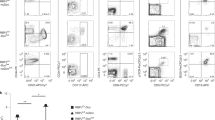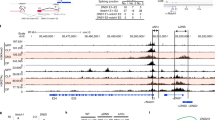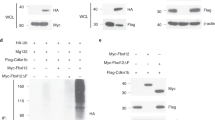Abstract
Signaling by the transmembrane receptor Notch is critical for T lineage development, but progenitor subsets that first receive Notch signals have not been defined. Here we identify an immature subset of early T lineage progenitors (ETPs) in the thymus that expressed the tyrosine kinase receptor Flt3 and had preserved B lineage potential at low progenitor frequency. Notch signaling was active in ETPs and was required for generation of the ETP population. Additionally, Notch signals contributed to the subsequent differentiation of ETPs. In contrast, multipotent hematopoietic progenitors circulated in the blood even in the absence of Notch signaling, suggesting that critical Notch signals during early T lineage development are delivered early after thymic entry.
This is a preview of subscription content, access via your institution
Access options
Subscribe to this journal
Receive 12 print issues and online access
$209.00 per year
only $17.42 per issue
Buy this article
- Purchase on Springer Link
- Instant access to full article PDF
Prices may be subject to local taxes which are calculated during checkout







Similar content being viewed by others
References
Donskoy, E. & Goldschneider, I. Thymocytopoiesis is maintained by blood-borne precursors throughout postnatal life. A study in parabiotic mice. J. Immunol. 148, 1604–1612 (1992).
Foss, D.L., Donskoy, E. & Goldschneider, I. The importation of hematogenous precursors by the thymus is a gated phenomenon in normal adult mice. J. Exp. Med. 193, 365–374 (2001).
Petrie, H.T., Hugo, P., Scollay, R. & Shortman, K. Lineage relationships and developmental kinetics of immature thymocytes: CD3, CD4, and CD8 acquisition in vivo and in vitro. J. Exp. Med. 172, 1583–1588 (1990).
Godfrey, D.I., Kennedy, J., Suda, T. & Zlotnik, A. A developmental pathway involving four phenotypically and functionally distinct subsets of CD3−CD4−CD8− triple-negative adult mouse thymocytes defined by CD44 and CD25 expression. J. Immunol. 150, 4244–4252 (1993).
Allman, D. et al. Thymopoiesis independent of common lymphoid progenitors. Nat. Immunol. 4, 168–174 (2003).
Porritt, H.E. et al. Heterogeneity among DN1 prothymocytes reveals multiple progenitors with different capacities to generate T cell and non-T cell lineages. Immunity 20, 735–745 (2004).
Balciunaite, G., Ceredig, R. & Rolink, A.G. The earliest subpopulation of mouse thymocytes contains potent T, significant macrophage and natural killer, but no B lymphocyte potential. Blood 105, 1930–1936 (2004).
Schwarz, B.A. & Bhandoola, A. Circulating hematopoietic progenitors with T lineage potential. Nat. Immunol. 5, 953–960 (2004).
Kondo, M., Weissman, I.L. & Akashi, K. Identification of clonogenic common lymphoid progenitors in mouse bone marrow. Cell 91, 661–672 (1997).
Martin, C.H. et al. Efficient thymic immigration of B220+ lymphoid-restricted bone marrow cells with T precursor potential. Nat. Immunol. 4, 866–873 (2003).
Radtke, F., Wilson, A., Mancini, S.J. & MacDonald, H.R. Notch regulation of lymphocyte development and function. Nat. Immunol. 5, 247–253 (2004).
Maillard, I., Fang, T. & Pear, W.S. Regulation of lymphoid development, differentiation and function by the Notch pathway. Annu. Rev. Immunol. 23, 945–974 (2005).
Radtke, F. et al. Deficient T cell fate specification in mice with an induced inactivation of Notch1. Immunity 10, 547–558 (1999).
Wilson, A., MacDonald, H.R. & Radtke, F. Notch 1-deficient common lymphoid precursors adopt a B cell fate in the thymus. J. Exp. Med. 194, 1003–1012 (2001).
Adolfsson, J. et al. Upregulation of Flt3 expression within the bone marrow Lin−Sca1+c-kit+ stem cell compartment is accompanied by loss of self-renewal capacity. Immunity 15, 659–669 (2001).
Christensen, J.L. & Weissman, I.L. Flk-2 is a marker in hematopoietic stem cell differentiation: a simple method to isolate long-term stem cells. Proc. Natl. Acad. Sci. USA 98, 14541–14546 (2001).
Adolfsson, J. et al. Identification of flt3+ lympho-myeloid stem cells lacking erythro-megakaryocytic potential a revised road map for adult blood lineage commitment. Cell 121, 295–306 (2005).
Sitnicka, E. et al. Key role of flt3 ligand in regulation of the common lymphoid progenitor but not in maintenance of the hematopoietic stem cell pool. Immunity 17, 463–472 (2002).
Sitnicka, E. et al. Complementary signaling through flt3 and interleukin-7 receptor α is indispensable for fetal and adult B cell genesis. J. Exp. Med. 198, 1495–1506 (2003).
Mackarehtschian, K. et al. Targeted disruption of the flk2/flt3 gene leads to deficiencies in primitive hematopoietic progenitors. Immunity 3, 147–161 (1995).
Weng, A.P. et al. Growth suppression of pre-T acute lymphoblastic leukemia cells by inhibition of notch signaling. Mol. Cell. Biol. 23, 655–664 (2003).
Maillard, I. et al. Mastermind critically regulates Notch-mediated lymphoid cell fate decisions. Blood 104, 1696–1702 (2004).
Schmitt, T.M. & Zuniga-Pflucker, J.C. Induction of T cell development from hematopoietic progenitor cells by delta-like-1 in vitro. Immunity 17, 749–756 (2002).
D'Amico, A. & Wu, L. The early progenitors of mouse dendritic cells and plasmacytoid predendritic cells are within the bone marrow hemopoietic precursors expressing Flt3. J. Exp. Med. 198, 293–303 (2003).
Moore, T.A. & Zlotnik, A. Differential effects of Flk-2/Flt-3 ligand and stem cell factor on murine thymic progenitor cells. J. Immunol. 158, 4187–4192 (1997).
McKenna, H.J. et al. Mice lacking flt3 ligand have deficient hematopoiesis affecting hematopoietic progenitor cells, dendritic cells, and natural killer cells. Blood 95, 3489–3497 (2000).
Deftos, M.L., Huang, E., Ojala, E.W., Forbush, K.A. & Bevan, M.J. Notch1 signaling promotes the maturation of CD4 and CD8 SP thymocytes. Immunity 13, 73–84 (2000).
Bellavia, D. et al. Constitutive activation of NF-κB and T-cell leukemia/lymphoma in Notch3 transgenic mice. EMBO J. 19, 3337–3348 (2000).
Ting, C.N., Olson, M.C., Barton, K.P. & Leiden, J.M. Transcription factor GATA-3 is required for development of the T-cell lineage. Nature 384, 474–478 (1996).
Hoflinger, S. et al. Analysis of Notch1 function by in vitro T cell differentiation of Pax5 mutant lymphoid progenitors. J. Immunol. 173, 3935–3944 (2004).
Rothenberg, E.V. & Taghon, T. Molecular Genetics of T Cell Development. Annu. Rev. Immunol. 23, 601–649 (2005).
Hendriks, R.W. et al. Expression of the transcription factor GATA-3 is required for the development of the earliest T cell progenitors and correlates with stages of cellular proliferation in the thymus. Eur. J. Immunol. 29, 1912–1918 (1999).
Pui, J.C. et al. Notch1 expression in early lymphopoiesis influences B versus T lineage determination. Immunity 11, 299–308 (1999).
Spangrude, G.J. & Scollay, R. Differentiation of hematopoietic stem cells in irradiated mouse thymic lobes. Kinetics and phenotype of progeny. J. Immunol. 145, 3661–3668 (1990).
Scollay, R., Smith, J. & Stauffer, V. Dynamics of early T cells: prothymocyte migration and proliferation in the adult mouse thymus. Immunol. Rev. 91, 129–157 (1986).
Buza-Vidas, N. et al. Critical and complementary role of Flt3 and interleukin 7-receptor α signaling in T lymphocyte development. Blood 104, Abstract 112 (2004).
Yun, T.J. & Bevan, M.J. Notch-regulated ankyrin-repeat protein inhibits Notch1 signaling: multiple Notch1 signaling pathways involved in T cell development. J. Immunol. 170, 5834–5841 (2003).
Saito, T. et al. Notch2 is preferentially expressed in mature B cells and indispensable for marginal zone B lineage development. Immunity 18, 675–685 (2003).
Fryer, C.J., White, J.B. & Jones, K.A. Mastermind recruits CycC:CDK8 to phosphorylate the Notch ICD and coordinate activation with turnover. Mol. Cell 16, 509–520 (2004).
Lehar, S.M., Dooley, J., Farr, A.G. & Bevan, M.J. Notch ligands Delta1 and Jagged1 transmit distinct signals to T cell precursors. Blood 105, 1440–1447 (2005).
Schmitt, T.M., Ciofani, M., Petrie, H.T. & Zuniga-Pflucker, J.C. Maintenance of T cell specification and differentiation requires recurrent notch receptor-ligand interactions. J. Exp. Med. 200, 469–479 (2004).
Perry, S.S., Pierce, L.J., Slayton, W.B. & Spangrude, G.J. Characterization of thymic progenitors in adult mouse bone marrow. J. Immunol. 170, 1877–1886 (2003).
Perry, S.S. et al. L-selectin defines a bone marrow analog to the thymic early T-lineage progenitor. Blood 103, 2990–2996 (2004).
Igarashi, H., Gregory, S.C., Yokota, T., Sakaguchi, N. & Kincade, P.W. Transcription from the RAG1 locus marks the earliest lymphocyte progenitors in bone marrow. Immunity 17, 117–130 (2002).
Ordentlich, P. et al. Notch inhibition of E47 supports the existence of a novel signaling pathway. Mol. Cell. Biol. 18, 2230–2239 (1998).
Nie, L., Xu, M., Vladimirova, A. & Sun, X.H. Notch-induced E2A ubiquitination and degradation are controlled by MAP kinase activities. EMBO J. 22, 5780–5792 (2003).
Taghon, T., David, E.S., Zuniga-Pflucker, J.C. & Rothenberg, E.V. Delayed, asynchronous, and reversible T-lineage specification induced by Notch/Delta signaling. Genes Dev. 19, 965–978 (2005).
Han, H. et al. Inducible gene knockout of transcription factor recombination signal binding protein-J reveals its essential role in T versus B lineage decision. Int. Immunol. 14, 637–645 (2002).
Koch, U. et al. Subversion of the T/B lineage decision in the thymus by lunatic fringe-mediated inhibition of Notch-1. Immunity 15, 225–236 (2001).
Carlyle, J.R. & Zuniga-Pflucker, J.C. Lineage commitment and differentiation of T and natural killer lymphocytes in the fetal mouse. Immunol. Rev. 165, 63–74 (1998).
Ceredig, R. The ontogeny of B cells in the thymus of normal, CD3 epsilon knockout (KO), RAG-2 KO and IL-7 transgenic mice. Int. Immunol. 14, 87–99 (2002).
Hashimoto, Y., Montecino-Rodriguez, E., Leathers, H., Stephan, R.P. & Dorshkind, K. B-cell development in the thymus is limited by inhibitory signals from the thymic microenvironment. Blood 100, 3504–3511 (2002).
Goldschneider, I., Komschlies, K.L. & Greiner, D.L. Studies of thymocytopoiesis in rats and mice. I. Kinetics of appearance of thymocytes using a direct intrathymic adoptive transfer assay for thymocyte precursors. J. Exp. Med. 163, 1–17 (1986).
Acknowledgements
We thank A. Carpenter, S. Mahmud, M. Velez, H. Sai and O. Shestova for technical assistance; D. Allman, G. Koretzky and B. Schwarz for critical reading of the manuscript; and R. Schretzenmair and H. Pletcher of the Abramson Cancer Center Flow Cytometry and Cell Sorting Shared Resource for technical expertise. Supported by the Swiss Society for Grants in Medicine and Biology (I.M.), the Damon Runyon Cancer Research Foundation (DRG-102-05; I.M.), the National Institutes of Health (R.M.G., J.C.A., W.S.P. and A.B.), the National Institutes of Health National Cancer Institute training program in Immunobiology of Normal and Neoplastic Lymphocytes (T32-CA-09140), the Leukemia and Lymphoma Society (Specialized Center of Research grant; W.S.P.) and the Commonwealth of Pennsylvania (Health Research Faculty Development Block Grant; W.S.P. and A.B.).
Author information
Authors and Affiliations
Corresponding author
Ethics declarations
Competing interests
The authors declare no competing financial interests.
Supplementary information
Supplementary Fig. 1
In vitro B lineage potential of DN1 thymocyte fractions. (PDF 552 kb)
Supplementary Fig. 2
In vivo B lineage potential of ETPs was not related to contaminating DN1c cells. (PDF 1538 kb)
Supplementary Fig. 3
Notch-dependence of DN1a-e thymocyte fractions. (PDF 1488 kb)
Supplementary Fig. 4
Expansion of committed intrathymic B lineage progenitors in the absence of Notch signaling. (PDF 1242 kb)
Rights and permissions
About this article
Cite this article
Sambandam, A., Maillard, I., Zediak, V. et al. Notch signaling controls the generation and differentiation of early T lineage progenitors. Nat Immunol 6, 663–670 (2005). https://doi.org/10.1038/ni1216
Received:
Accepted:
Published:
Issue Date:
DOI: https://doi.org/10.1038/ni1216
This article is cited by
-
A double-negative thymocyte-specific enhancer augments Notch1 signaling to direct early T cell progenitor expansion, lineage restriction and β-selection
Nature Immunology (2022)
-
Logical modeling of thymus and natural killer lymphocyte differentiation
Journal of Biological Physics (2021)
-
Fibrotic liver microenvironment promotes Dll4 and SDF-1-dependent T-cell lineage development
Cell Death & Disease (2019)
-
RBPJ-dependent Notch signaling initiates the T cell program in a subset of thymus-seeding progenitors
Nature Immunology (2019)
-
Hormonal control of T-cell development in health and disease
Nature Reviews Endocrinology (2016)



